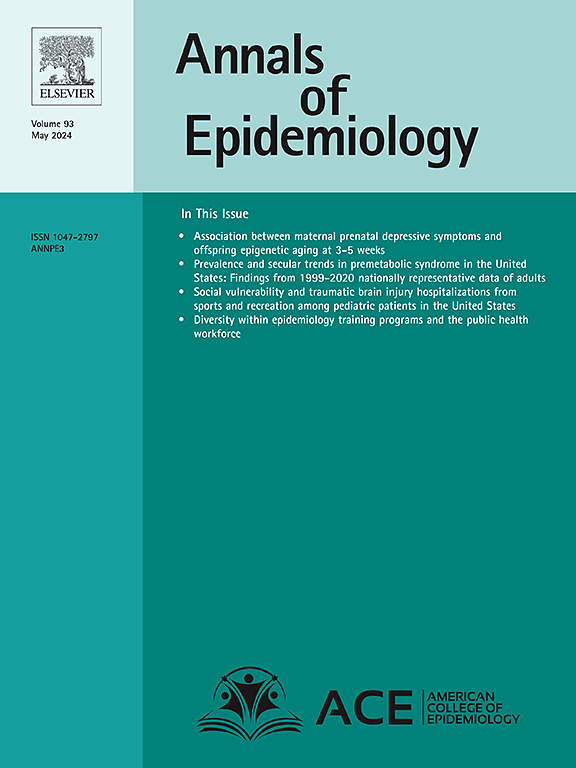虚弱的影响:可改变的风险因素与痴呆症之间的关联有何不同
IF 3.3
3区 医学
Q1 PUBLIC, ENVIRONMENTAL & OCCUPATIONAL HEALTH
引用次数: 0
摘要
背景柳叶刀委员会强调了 12 个可改变的痴呆症风险因素。然而,在异质性的老年人群中应对这些风险因素的效果尚不完全清楚。我们按虚弱程度比较了风险因素与痴呆症之间的关联,虚弱程度被认为是老年期潜在健康异质性的一种解释。方法数据来自英国生物库,这是一项队列研究,2006 年至 2010 年间有超过 50 万名年龄在 37-73 岁之间的参与者参加。衡量虚弱的标准有五个:迟钝、虚弱、疲惫、不活动和萎缩。符合 0、1-2 和 3-5 项标准的参与者分别被认为是非虚弱者、前期虚弱者和虚弱者。我们纳入了 13 个可改变的风险因素。我们使用逻辑回归法分别确定了非体弱者、体弱前期和体弱者中风险因素与 10 年痴呆症的关联。结果 在 381 419 名参与者中,分别有 58.4%、38.2% 和 3.4% 的人被归类为非体弱者、体弱前期和体弱者。除吸烟、抑郁和过度饮酒外,其他 10 个风险因素与体弱者痴呆症的关系更为密切。在考虑针对低教育程度、缺乏运动、中心性肥胖、社会隔离、听力障碍、高血压、糖尿病、高二氧化氮(NO2)暴露、高直径小于或等于 2.5 微米的颗粒物(PM2.5)暴露和脑外伤的假设干预时,我们观察到体弱者的 PIEs 最高。对于针对所有 13 个风险因素的假定干预措施,我们发现不同体弱状态下的 PIE 会分级增加。我们主张结合虚弱程度评估来确定最有可能从有针对性的风险因素干预中受益的人群。本文章由计算机程序翻译,如有差异,请以英文原文为准。
The influence of frailty: How the associations between modifiable risk factors and dementia vary
Background
The Lancet Commission has highlighted 12 modifiable risk factors for dementia. However, the effects of addressing these risk factors among the heterogeneous older adult population is not fully understood. We compared the association between risk factors and dementia by frailty, conceptualized as an explanation for the underlying health heterogeneity in old age.
Methods
Data were from the UK Biobank, a cohort study with over 500,000 participants aged 37–73 between 2006 and 2010. Frailty was measured by five criteria: slowness, weakness, exhaustion, inactivity, and shrinking. Participants meeting 0, 1–2, and 3–5 criteria were considered non-frail, prefrail, and frail, respectively. We included 13 modifiable risk factors. We used logistic regression to determine the associations of risk factors with 10-year dementia among non-frail, pre-frail, and frail individuals, respectively. Additionally, we adopted a g-computation method to estimate the individual and combined population intervention effects (PIE) of the risk factors for dementia.
Results
Of 381,419 participants, 58.4 %, 38.2 %, and 3.4 % were classified as non-frail, pre-frail, and frail, respectively. Except for smoking, depression, and excessive alcohol use, the other 10 risk factors had a stronger association with dementia among frailer individuals. We observed the highest PIEs among frail individuals when considering hypothetical interventions targeting low education, physical inactivity, central obesity, social isolation, hearing impairment, hypertension, diabetes, high nitrogen dioxide (NO2) exposure, high exposure of particulate matter with a diameter less than or equal to 2.5 micrometers (PM2.5), and traumatic brain injury individually. For the hypothetical interventions targeting all 13 risk factors together, we found a graded increase in the PIE across frailty status.
Conclusion
The associations between modifiable risk factors and dementia were stronger among the frail. We advocate for incorporating frailty assessments to pinpoint those most likely to benefit from targeted risk factor interventions.
求助全文
通过发布文献求助,成功后即可免费获取论文全文。
去求助
来源期刊

Annals of Epidemiology
医学-公共卫生、环境卫生与职业卫生
CiteScore
7.40
自引率
1.80%
发文量
207
审稿时长
59 days
期刊介绍:
The journal emphasizes the application of epidemiologic methods to issues that affect the distribution and determinants of human illness in diverse contexts. Its primary focus is on chronic and acute conditions of diverse etiologies and of major importance to clinical medicine, public health, and health care delivery.
 求助内容:
求助内容: 应助结果提醒方式:
应助结果提醒方式:


